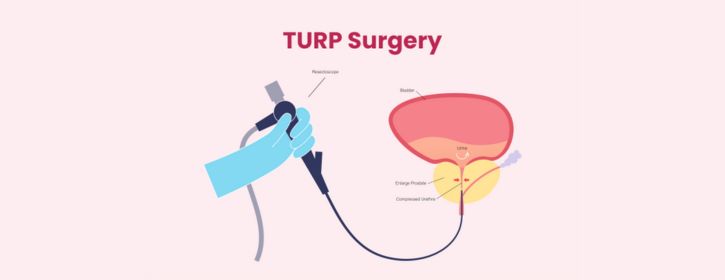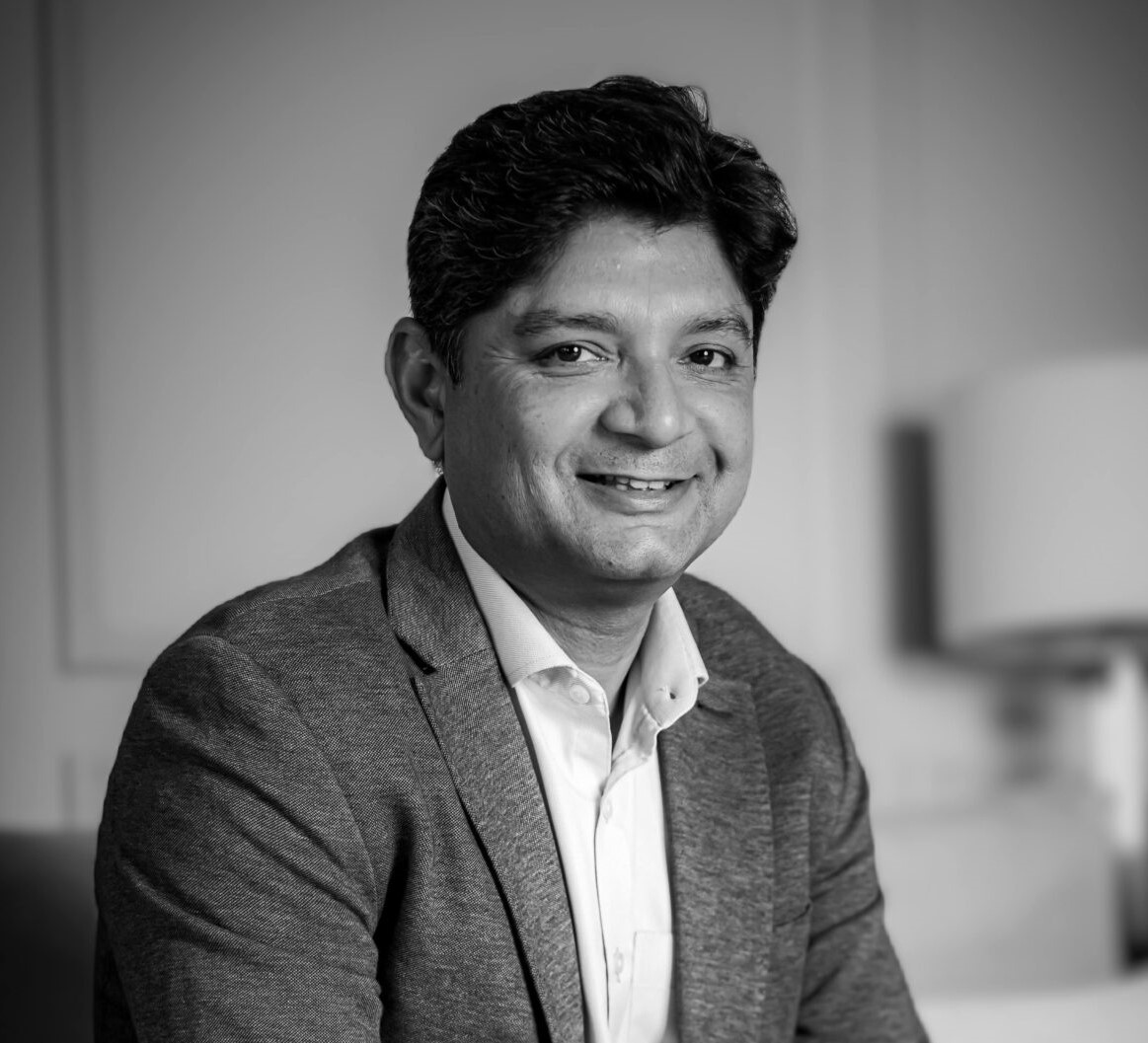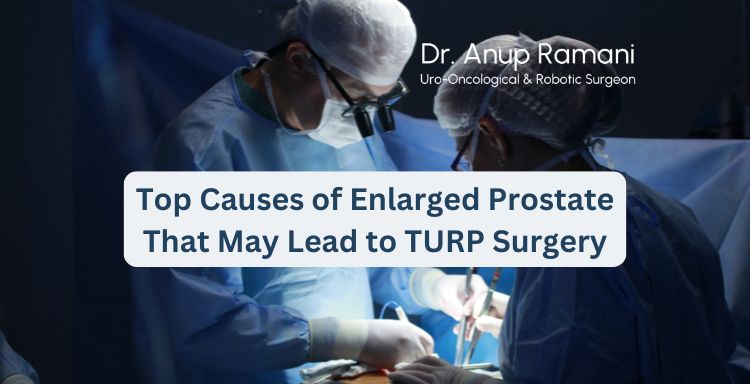Dr Anup Ramani @ Copyright 2024
By Dr. Anup Ramani
Enlarged prostate is a common condition that affects older men. It occurs when the prostate gland, which is located below the bladder and surrounds the urethra, grows larger. As the prostate enlarges, it can exert pressure on the urethra, causing difficulties with urination. Symptoms of BPH, such as frequent urination, difficulty starting or stopping urination and weak urine flow, are common in older men and May significantly affect their quality of life.
In cases where symptoms become severe and cannot be managed through medication or lifestyle changes, Enlarged Prostate Surgery, specifically Transurethral Resection of the Prostate (TURP), may be recommended. TURP is a minimal invasive procedure that can provide relief from urinary problems caused by an enlarged prostate.
This article will discuss the top causes of an enlarged prostate that can lead to TURP surgery and the available treatment options, focusing on advancements in Enlarged Prostate Surgery in India.
What is an Enlarged Prostate?
The prostate is a small, walnut-shaped gland in men that produces seminal fluid to nourish and transport sperm. As men age, the prostate can enlarge, which is a normal part of aging. This condition, known as benign prostatic hyperplasia (BPH), is non-cancerous but can lead to uncomfortable and sometimes serious urinary symptoms.
While BPH is common, it can lead to complications if left untreated. In many cases, as the prostate grows, it can obstruct the urethra, affecting the flow of urine and causing a range of symptoms such as:
- Difficulty starting or stopping urination
- Frequent urination, especially at night
- Weak urine stream or dribbling
- Painful urination or blood in the urine
- Inability to completely empty the bladder
For many men, these symptoms become progressively worse over time, leading them to seek medical intervention. If medications and other treatments do not relieve the symptoms, TURP surgery may be necessary.
What Our Patients Are Saying
Top Causes of Enlarged Prostate That May Lead to TURP Surgery
Although BPH is the primary cause of an enlarged prostate, other factors can contribute to the development and worsening of this condition. Understanding the leading causes can help in early diagnosis and intervention, preventing the need for more invasive procedures like TURP.

Aging and Hormonal Changes
The most significant factor contributing to an enlarged prostate is the natural process of aging. As men get older, hormonal changes occur, which influence prostate growth. The levels of these hormones rise and remain elevated with age, stimulating prostate cells to multiply.
As a result, the prostate gradually enlarges over time, putting pressure on the urethra and affecting urine flow. While this enlargement is typically non-cancerous, it can lead to BPH and significantly affect a man’s urinary function.
TURP Surgery Consideration: If symptoms become severe and quality of life is impacted, TURP surgery may be necessary to remove excess prostate tissue and relieve the blockage.
Genetic Predisposition
Genetic factors play a crucial role in the development of BPH. A family history of enlarged prostate can increase a man’s risk of developing the condition. Studies have shown that men with close relatives, such as fathers or brothers, who have had BPH, are more likely to experience the same issue.
While genetics alone may not directly cause an enlarged prostate, they can increase the likelihood of developing symptoms as the prostate enlarges with age. Early monitoring and preventive measures may help manage symptoms before surgery becomes necessary.
TURP Surgery Consideration: If symptoms worsen due to a hereditary predisposition, Enlarged Prostate Surgery like TURP may be needed to improve urination and prevent complications.
Obesity and Lifestyle Factors
Obesity and an unhealthy lifestyle are linked to an increased risk of BPH. Men with higher body mass indexes (BMI) tend to experience more significant prostate growth. Poor dietary habits, lack of physical activity and increased abdominal fat can lead to hormonal imbalances that trigger prostate enlargement.
Additionally, conditions related to obesity, such as diabetes, hypertension and cardiovascular diseases may exacerbate prostate problems. The relationship between weight gain and BPH is still under research, but lifestyle changes, including a healthy diet and exercise, can help manage symptoms.
TURP Surgery Consideration: For men with severe symptoms from obesity-related BPH, TURP surgery may be recommended to alleviate symptoms like urinary retention and nocturia (frequent nighttime urination).
Hormonal Imbalances (Estrogen and Testosterone)
As men age, the balance between testosterone and estrogen in their body’s changes. Testosterone levels naturally decrease with age, while estrogen levels tend to remain constant or slightly increase. This hormonal shift can lead to prostate enlargement, as estrogen plays a role in prostate cell growth.
Testosterone is the primary male hormone that regulates prostate function, while estrogen influences the growth of prostate tissue. As the hormonal balance shifts, prostate cells may begin to grow uncontrollably, leading to BPH.
TURP Surgery Consideration: If the prostate grows excessively due to hormonal changes, this surgery may be necessary to remove excess prostate tissue and relieve urinary symptoms caused by obstruction.

Inflammation and Infection
Chronic inflammation of the prostate, often resulting from urinary tract infections (UTIs) or prostatitis (inflammation of the prostate), can contribute to prostate enlargement. Persistent infections or inflammation may lead to scar tissue formation, which can restrict urine flow and contribute to BPH symptoms.
Inflammation can also exacerbate existing prostate issues and trigger further growth. Treating underlying infections and inflammation can sometimes alleviate symptoms, but when these issues become chronic, surgery may be required to prevent long-term damage.
TURP Surgery Consideration: If inflammation leads to significant prostate enlargement and urinary obstruction, Enlarged Prostate Surgery such as TURP may be needed to restore normal bladder function.
Medications and Other Medical Conditions
Certain medications, particularly those used to treat conditions like high blood pressure or depression, can contribute to the enlargement of the prostate. For example, alpha-blockers used to manage hypertension can relax the muscles around the prostate, but they may also worsen symptoms of BPH in some cases.
Other medical conditions, such as diabetes, high cholesterol and cardiovascular diseases, are also linked to an increased risk of developing an enlarged prostate. These conditions can exacerbate the symptoms of BPH and lead to the need for surgical intervention if left untreated.
TURP Surgery Consideration: Men with severe symptoms of BPH exacerbated by other medical conditions may require surgery to remove the enlarged prostate tissue and improve urinary function.
Enlarged Prostate Treatment Options and TURP Surgery
When symptoms of an enlarged prostate become severe and affect daily life, TURP surgery may be recommended. It is a minimal invasive procedure in which excess prostate tissue is removed using an endoscope inserted through the urethra. This procedure is typically performed under spinal anesthesia and the recovery time is relatively short.
In Mumbai and across India, Enlarged Prostate Surgery is widely available with highly skilled surgeons using advanced techniques, to achieve optimal results for patients.
Conclusion
Enlarged prostate (BPH) is a common condition in older men and its causes can range from hormonal changes to genetic predisposition, lifestyle factors and chronic inflammation. When symptoms of BPH become severe, TURP surgery is often recommended as an effective solution to relieve urinary obstruction and improve quality of life.
If you are experiencing symptoms of an enlarged prostate, it is crucial to seek medical attention promptly to discuss the best course of treatment. Dr. Anup Ramani offers Enlarged Prostate Treatment in India, particularly in Mumbai, offers advanced surgical options, which can provide relief and improve urinary function for patients suffering from this common condition.
FAQs
What are the most common symptoms of an enlarged prostate?
Common symptoms include frequent urination, weak urine stream, and difficulty starting or stopping urination and waking up frequently at night to urinate.
When should TURP surgery be considered?
TURP surgery is considered when BPH symptoms become severe and affect daily life and when medications or lifestyle changes are ineffective.
What happens during a TURP surgery?
TURP involves the removal of excess prostate tissue using a laser or other instruments inserted through the urethra. The procedure typically takes about 40 minutes and patients can walk the same day.
Is TURP surgery painful?
TURP surgery is minimal invasive and generally not painful due to spinal anesthesia. Most patients experience mild discomfort post-surgery, which subsides quickly.
About Author

Uro-Oncological & Robotic Surgeon
Dr. Anup Ramani is a robotic uro-oncological surgeon and an internationally recognized expert in robotic surgery for prostate, kidney and urinary bladder cancers. With more than two decades of robotic experience and 2,000+ robotic procedures, he brings unmatched precision and outcomes to complex uro-oncology cases. He is widely published in his field and is known for a personal, transparent approach-often spending over an hour in initial consultations to educate patients on its disease, surgery and recovery. His expertise spans prostate cancer treatment, kidney and bladder cancer surgery, adrenal gland surgery, kidney stone treatment, penile cancer surgery and enlarged prostate management. Dr. Ramani advocates the advantages of robotic surgery-magnified 3D vision, tremor-filtered precision, minimal scarring, lower blood loss and faster recovery-helping patients return to life sooner.
Best Uro-Oncological surgeon
Specialist in India for Robotic Surgery
MCh, DNB, MS, DNB
Dr. Anup Ramani
CONTACT
Uro-Oncologist in India,
Best Robotic Surgeon for Uro Oncology Surgery
1407, One Lodha Place Next to World Towers Senapati Bapat Marg, Worli, Mumbai. 400013.
Dr Anup Ramani @ Copyright 2024 – Website Maintenance, SEO & GEO by Opal Infotech
- Partial penectomy is done in cases where glans and distal penis is involved with carcinoma.
- Partial penectomy is a type of organ-preserving surgery. Preservation of sexual and micturational function depends on the surgical dissection and reconstruction of residual urethra.
- Patients who develop stones in the kidney or ureter, often experience severe pain.
- This condition usually needs a procedure to remove the kidney stones.
- This procedure is called ureteroscopy and is performed very commonly.
- It does not require any cuts and hence it is painless.
- The procedure is performed with an endoscope inserted through the penis under spinal anesthesia.
- The scope is inserted through the penis into the kidney and stones are dissolved with a laser.
- The procedure takes about 40-50 minutes.
- A catheter (urine pipe) is kept after the procedure to drain the bladder. A stent is kept in the kidney at the same time.
- Patient is mobile and walking in the room the same evening.
- Hospital stay is one night and patient is discharged the next day after removal of the catheter.
- Patient has to come back after six weeks to remove the stent in the kidney.
- Patients can resume office a week after surgery and heavy activities like running, weight lifting, a month after the procedure.
- We offer fixed packages for this procedure which can be obtained by calling our helpline +91 9967666060.
- Men with an enlarged prostate, which is a normal ageing changes, often experiencing difficulty passing urine. This condition usually needs a procedure to trim the prostate and relieve the blockage.
- This procedure is called TURP and is performed very commonly.
- It does not require any cuts and hence it is painless.
- The procedure is performed with an endoscope inserted through the penis under spinal anaesthesia.
- The overgrown prostate is dissolved with a laser bloodlessly.
- The procedure takes about 40 minutes.
- A catheter (urine pipe) is kept after the procedure to drain the bladder.
- Patient is mobile and walking in the room the same evening.
- Hospital stay is two nights and patient is discharged with the catheter, which is removed after 4 days.
- Patients can resume office a week after surgery and heavy activities like running, weight lifting, a month after the procedure.
- We offer fixed packages for this procedure which can be obtained by calling our helpline +91 9967666060.
-
Robotic adrenalectomy is a sophisticated, complex surgery and it is very important that an experienced surgeon performs this surgery to avoid major complications.
-
Once the anesthesia is done, and patient positioned, three micro cuts (3mm each) are made in the patient’s abdomen.
-
The arms of the Da Vinci robot are connected to the cuts via ports (tubes).
-
Dr. Ramani then sits in the controlling console to perform the surgery.
-
On an average, a robotic adrenalectomy takes one hour.
-
The surgery is almost completely bloodless and there has never been any need to transfuse blood after surgery.
-
A urine catheter and bag to drain the bladder is inserted during surgery.
-
A tiny drain pipe may be inserted in the surgical side of the abdomen, connected to a bag.
-
Patient is kept nil-by-mouth the day of the surgery, with IV fluids. Sips of water are started the next day and solid food by day three.
-
The drain pipe, if kept, is removed in the room on day 2 after surgery.
-
The catheter is removed on day two after surgery.
-
Total hospital stay for robotic adrenalectomy is 4 nights (including night before surgery).
-
Post discharge, a doctor from the surgical team visits the patient at home/ hotel room once every day.
On the day of discharge, patient is totally self-sufficient. They are able to walk freely without any pain, dress themselves, shower, toilet and they do not need to hire any nurse or help at home. Almost all patients are back to work within 2 weeks of surgery.
Heavy activities like running, weight lifting can be resumed after a month
Follow up after an adrenalectomy is in the form of CT scans, once a year for 5 years.
Local patients usually meet Dr. Ramani after two weeks to discuss report.Outstation patients are counselled on a phone consultation.
- Dr. Ramani is one of the very few surgeons in India who has the expertise to perform a robotic surgery for bladder cancer, which includes removing the urinary bladder and reconstructing a new bladder robotically.
- Robotic radical cystectomy is an extremely sophisticated, complex surgery and it is very important that an experienced surgeon performs this surgery to avoid major complications.
- Once the anaesthesia is done, and patient positioned, six micro cuts (3mm each) are made in the patient’s abdomen.
- The arms of the Da Vinci robot are connected to the cuts via ports (tubes).
- Dr. Ramani then sits in the controlling console to perform the surgery.
- On an average, a robotic radical cystectomy with an ileal conduit takes 3-4 hours.
- The surgery is almost completely bloodless and there has never been any need to transfuse blood after surgery.
- A urine catheter and bag to drain the new bladder is inserted during surgery.
- Two tiny drain pipe in inserted in the surgical side of the abdomen, connected to a bag.
- Patient is kept nil-by-mouth for 4 days after surgery with IV supplementation of patient’s daily requirements of calories, fats, carbohydrates, proteins and electrolytes.
- The drain pipes are removed in the room on day 3-5 after surgery.
- Total hospital stay for radical cystectomy is 8 nights (including night before surgery).
- Post discharge, a doctor from the surgical team visits the patient at home/ hotel room once every day.
- On the day of discharge, patient is totally self-sufficient. They are able to walk freely without any pain, dress themselves, shower, toilet and they do not need to hire any nurse or help at home.
- Almost all patients are back to work within 6 weeks of surgery. Heavy activities like running, weight lifting can be resumed after two months.
Follow up after a radical a cystectomy is in the form of CT scans, once a year for 5 years.
Histopathology report: Local patients usually meet Dr. Ramani after two weeks to discuss report.
Outstation patients are counselled on a phone consult. Depending on the report, patient may or may not need chemotherapy after surgery.
If chemo is needed, patients may choose to get it done with a medical oncologist of their choice or avail the services of one of the four medical oncologists on our team.
- Robotic partial nephrectomy is a sophisticated, complex surgery and it is very important that an experienced surgeon performs this surgery to avoid major complications. Robotic radical (total) nephrectomy is
- relatively easier but still requires significant experience to consistently deliver results.
- Once the anaesthesia is done, and patient positioned, five micro cuts (3mm each) are made in the patient’s abdomen.
- The arms of the Da Vinci robot are connected to the cuts via ports (tubes).
- Dr. Ramani then sits in the controlling console to perform the surgery.
- On an average, a robotic radical nephrectomy takes one hour and a robotic partial nephrectomy takes about an hour and half.
- The surgery is almost completely bloodless and there has never been any need to transfuse blood after surgery.
- A urine catheter and bag to drain the bladder is inserted during surgery.
- A tiny drain pipe in inserted in the surgical side of the abdomen, connected to a bag.
- Patient is kept nil-by-mouth the day of the surgery, with IV fluids. Sips of water are started the next day and solid food by day three.
- The drain pipe is removed in the room on day 3 after surgery. The catheter is removed on day two after surgery.
- Total hospital stay for radical/partial nephrectomy is 4 nights (including night before surgery).
- Post discharge, a doctor from the surgical team visits the patient at home/ hotel room once every day.
- On the day of discharge, patient is totally self- sufficient.
- They are able to walk freely without any pain, dress themselves, shower, toilet and they do not need to hire any nurse or help at home.
- Almost all patients are back to work within 2-3 weeks of surgery.
- Heavy activities like running, weight lifting can be resumed after a month.
- Follow up after a radical/partial Nephrectomy is in the form of CT scans, once a year for 5 years.
- Local patients usually meet Dr. Ramani after two weeks to discuss report.
- Outstation patients are counselled on a phone consultation.





